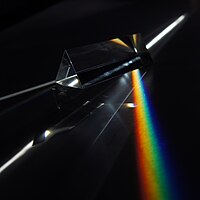
Photo from wikipedia
The next generation of multipetawatt laser facilities may enable new opportunities in radiation-pressure driven ion-acceleration. Owing to the motion of the thin solid foil used as a target in such… Click to show full abstract
The next generation of multipetawatt laser facilities may enable new opportunities in radiation-pressure driven ion-acceleration. Owing to the motion of the thin solid foil used as a target in such experiments, the laser light reflected from the surface will be Doppler downshifted. We show that the downshifted light can be correlated with the ion energies and may be used as a diagnostic of the acceleration mechanism. The possibility of using the back-scattered light in ion acceleration experiments to produce long-wavelength few-cycle pulses is also explored. The highest ion velocities are obtained in the light-sail regime, the theory of which is here extended to regimes with varying reflectivity due to a time-dependent intensity. The reflected pulse with a large Doppler redshift and approximately linear chirp may subsequently be compressed using a grating compressor to obtain a near single cycle pulse with long wavelength and relatively high intensity. Analytic estimates are supported by 1D3P relativistic particle-in-cell simulations.
Journal Title: Plasma Physics and Controlled Fusion
Year Published: 2023
Link to full text (if available)
Share on Social Media: Sign Up to like & get
recommendations!